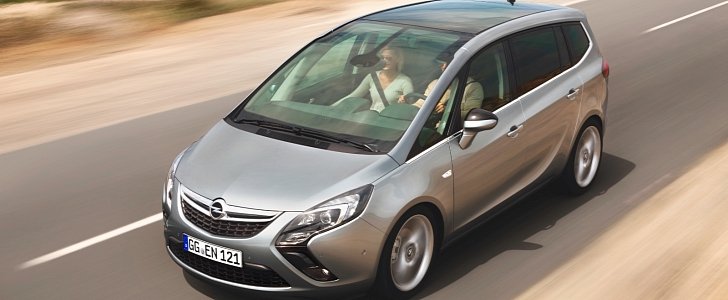Opel has released an official statement in which it rejects the allegations made by Belgian Journalist Luc Pauwels on VRT News.
In case you missed our story on the topic yesterday and didn’t get the chance to see the update we made with the official press release on the subject, it is time for a quick recap to bring clarity to this situation.
A journalist named Luc Pauwels took his Opel Astra to an official service shop for a free update. He was intrigued by the timing of the letter that invited him to do this free update on the ignition system, so he decided to install a hidden video camera to record what exactly technicians were going to do to his vehicle.
While there was no suspicious activity on his car, the journalist taped a discussion between two people in the service area who were talking about an update to make the 1.6 diesel Zafira Tourer’s nitrogen oxide emissions lower.
He then decided to borrow two Opel Zafira Tourer vehicles with the 1.6 CDTI engine and test them for NOx emissions with the help of specialized company “Emissions Analytics.” So far so good, but the team discovered a discrepancy in the readings before and after the alleged software update on the Zafira Tourer’s 1.6-liter engine. The story quickly got published by several media outlets, before giving Opel a chance to an official reply. By the time we picked up on the story, the company had denied the claims made by the Belgian reporter.
Since the story got pretty popular online, Opel decided to issue a press release with more information regarding the situation.
The German company specified that the service bulletin 15-0-044 had nothing to do with changing emission levels on Opel cars. The specified service campaign has been discussed with Germany’s KPA, the Type Approval Authority.
Furthermore, the company stipulated that they did not initiate any recall to improve emission values for its cars in 2015.
The other issue the German brand wanted to address was the testing measures used and the little amount of information the story provided.
The issue is that the guys at “Emissions Analytics” haven’t detailed their execution of the NEDC (New European Driving Cycle) and the RDE (Real Driving Emissions) tests to bring a clear conclusion on the situation. As Opel points out, even the specialized company admits that their tests might deviate from standardized trials. Another indication of this outcome would be the history of the test vehicles themselves.
In December 2015, Opel announced it decided to publish fuel consumption and emission figures recorded under the WLTP cycle (Worldwide Harmonized Light Duty Vehicles Test Procedure) and showcase them along with the usual NEDC figures starting summer 2016.
The company’s engineers are also working on improvements to their Selective Catalytic Reduction on diesel engines to provide an early improvement in emissions before the future RDE legislation (Real Driving Emissions) goes into effect, in 2017.
A journalist named Luc Pauwels took his Opel Astra to an official service shop for a free update. He was intrigued by the timing of the letter that invited him to do this free update on the ignition system, so he decided to install a hidden video camera to record what exactly technicians were going to do to his vehicle.
While there was no suspicious activity on his car, the journalist taped a discussion between two people in the service area who were talking about an update to make the 1.6 diesel Zafira Tourer’s nitrogen oxide emissions lower.
He then decided to borrow two Opel Zafira Tourer vehicles with the 1.6 CDTI engine and test them for NOx emissions with the help of specialized company “Emissions Analytics.” So far so good, but the team discovered a discrepancy in the readings before and after the alleged software update on the Zafira Tourer’s 1.6-liter engine. The story quickly got published by several media outlets, before giving Opel a chance to an official reply. By the time we picked up on the story, the company had denied the claims made by the Belgian reporter.
Since the story got pretty popular online, Opel decided to issue a press release with more information regarding the situation.
The German company specified that the service bulletin 15-0-044 had nothing to do with changing emission levels on Opel cars. The specified service campaign has been discussed with Germany’s KPA, the Type Approval Authority.
Furthermore, the company stipulated that they did not initiate any recall to improve emission values for its cars in 2015.
The other issue the German brand wanted to address was the testing measures used and the little amount of information the story provided.
The issue is that the guys at “Emissions Analytics” haven’t detailed their execution of the NEDC (New European Driving Cycle) and the RDE (Real Driving Emissions) tests to bring a clear conclusion on the situation. As Opel points out, even the specialized company admits that their tests might deviate from standardized trials. Another indication of this outcome would be the history of the test vehicles themselves.
In December 2015, Opel announced it decided to publish fuel consumption and emission figures recorded under the WLTP cycle (Worldwide Harmonized Light Duty Vehicles Test Procedure) and showcase them along with the usual NEDC figures starting summer 2016.
The company’s engineers are also working on improvements to their Selective Catalytic Reduction on diesel engines to provide an early improvement in emissions before the future RDE legislation (Real Driving Emissions) goes into effect, in 2017.

